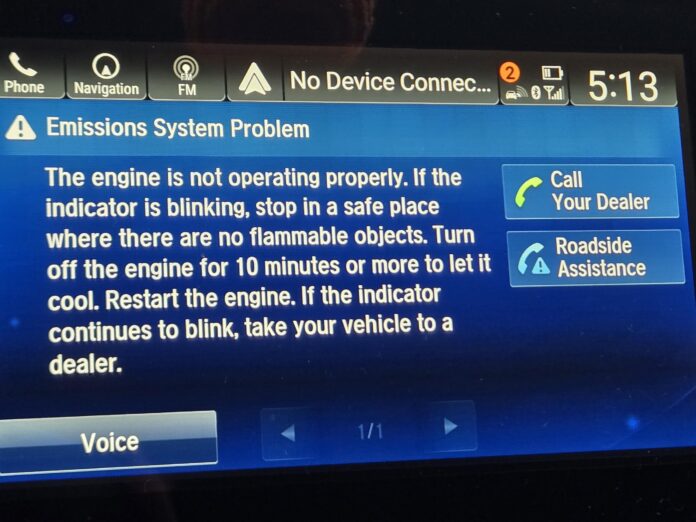Encountering an emission system issue in your Honda Odyssey can be concerning, but it’s a common problem that many owners face. These issues typically stem from malfunctioning components within the emissions system, triggering warning indicators on your dashboard. Understanding the causes and knowing how to troubleshoot them can help you avoid costly repairs and keep your vehicle running efficiently. Read on for practical solutions that will help you diagnose and resolve these problems effectively.
Frequent Emission System Problems in Honda Odyssey
The emission system in a Honda Odyssey can encounter various issues, primarily involving the catalytic converter, oxygen sensors, EVAP system, and air filtration. Recognizing these problems early can help you take the necessary steps to restore your vehicle’s performance and reduce emissions.
Issues with the Catalytic Converter
The catalytic converter plays a crucial role in minimizing harmful emissions by converting toxic gases into less harmful substances. When this component malfunctions, it can trigger the check engine light, affect engine performance, and lead to increased emissions. Causes of failure include contamination, overheating, or internal damage.
Symptoms of a faulty catalytic converter include sluggish acceleration, an unusual sulfur-like odor, and a rattling noise from underneath the vehicle. Regular maintenance, such as ensuring the engine burns fuel efficiently and using high-quality gasoline, can help extend the lifespan of the converter. If replacement becomes necessary, it can be costly, so early detection is essential.
Malfunctioning Oxygen Sensors
Oxygen sensors measure the oxygen levels in exhaust gases and play a vital role in fuel efficiency and emission control. A malfunctioning sensor can lead to inaccurate air-fuel mixture readings, causing reduced fuel efficiency, increased emissions, and check engine light warnings.
Oxygen sensors can fail due to contamination from oil, coolant leaks, or long-term wear. When this happens, replacing the faulty sensor is often the best solution. Regular maintenance and addressing engine issues promptly can help prevent sensor malfunctions and ensure optimal performance.
EVAP System Failures
The EVAP (Evaporative Emission Control System) is responsible for preventing fuel vapors from escaping into the atmosphere. If this system fails, you may notice a check engine light or a persistent fuel odor. Common causes include damaged purge valves, leaks in the fuel system, or faulty hoses.
Regular inspections can help catch minor EVAP system faults before they turn into significant issues. Fixes often involve replacing worn-out hoses, checking for leaks, or repairing malfunctioning valves. Addressing these problems early can help you avoid expensive repairs and keep emissions within regulatory limits.
Air Filtration Problems
A clogged or dirty air filter can significantly affect engine performance and emissions. The air filter prevents dust, debris, and other contaminants from entering the engine. Over time, a blocked filter can reduce airflow, leading to poor fuel combustion, increased emissions, and a drop in power.
Replacing the air filter regularly is a simple and cost-effective way to maintain engine efficiency. A clean air filter allows for better fuel combustion, helping to optimize fuel economy while reducing emissions.
Diagnosing Emission System Problems in a Honda Odyssey
When your Honda Odyssey’s emission system warning light comes on, diagnosing the problem accurately is key to resolving it. Using diagnostic tools, understanding error codes, and seeking professional assistance can help pinpoint the issue effectively.
Using OBD-II Diagnostic Tools
An OBD-II scanner is an essential tool for diagnosing emission-related issues. It connects to your vehicle’s onboard computer system and retrieves error codes, helping you identify the malfunctioning components.
To use the scanner, plug it into the OBD-II port, usually located beneath the dashboard. The tool will display specific codes that correspond to different emission system faults. Advanced scan tools provide real-time data, making it easier to assess the severity of the problem.
Understanding Emission System Error Codes
Emission-related error codes provide valuable insight into potential system failures. For instance, a P0420 code indicates an issue with the catalytic converter’s efficiency, while a P0455 suggests a major evaporative emissions leak, often due to a loose gas cap.
Understanding these codes helps in determining whether the issue requires an easy fix, like tightening the gas cap, or more extensive repairs. Always refer to your vehicle’s manual or consult a mechanic for accurate interpretations.
Seeking Professional Diagnosis
If the problem persists despite troubleshooting, consulting a certified mechanic is advisable. Professionals have advanced diagnostic equipment and expertise to detect issues beyond the capabilities of basic scanners.
Regular maintenance and timely repairs ensure your Honda Odyssey’s emission system remains in optimal condition, preventing major breakdowns and reducing environmental impact.

